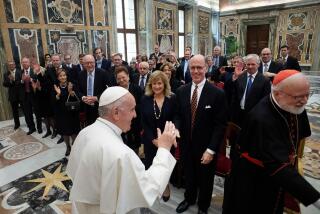Metal pope? Pope Francis flashes familiar hand signs in Philippines
An homage to the original Holy Diver? Maybe a White Sabbath celebration?
Or is Pope Francis a secret heavy metal aficionado?
Some of the most curious images of the pope’s recent tour of the Philippines show him flashing what to most music fans is instantly recognizable as the “devil’s sign.” This ancient hand signal is achieved by extending the index and pinky fingers and retracting the ring and middle fingers (the thumb is optional--Pope Francis leaves it outstretched, as in the Hawaiian shaka sign).
The “sign of the horns” goes back many centuries. It appears in medieval manuscripts and it’s a fixture of folkloric cultures around the Mediterranean. Italian families in particular use it to ward off the evil eye, and through one of rock’s most successful Italian Americans, Black Sabbath singer Ronnie James Dio (born Ronald James Padavona), it entered rock and roll and heavy metal lore. It has been a major signifier of dark, heavy music since the 1970s, and a staple of crowd support for acts who favor leather, studs and crushing guitar chords all around the world.
So what was Pope Francis doing flashing this sign last week in the Philippines?
The Associated Press caption helps clarify matters: “Pope Francis and Manila Archbishop Luis Antonio Tagle salute the crowd with the popular hand sign for ‘I love you’ during a meeting with families at the Mall of Asia arena in Manila, Philippines, Friday, Jan. 16, 2015. Walking into a packed 20,000-seat arena, Francis greeted and blessed the people who lined his long way to the stage.”
Yes, the “evil eye” and “Black Sabbath” sign apparently means “I Love You” in the Philippines, and in American Sign Language (“I Love You,” in general, not “I Love You, Mötley Crüe”).
As for Pope Francis’ musical tastes, back when he was merely Argentine Cardinal Jorge Bergoglio he was interviewed for the book “The Jesuit,” and he disclosed a fondness for tangos (which he danced in his youth, particularly the sprightly “milonga” variation) and Beethoven’s Lenora Overture, especially the version conducted by Walter Furtwängler.
He’s never spoken (ex cathedra or otherwise), however, about his stance for or against righteous metal.
Twitter: @eyecantina
More to Read
The biggest entertainment stories
Get our big stories about Hollywood, film, television, music, arts, culture and more right in your inbox as soon as they publish.
You may occasionally receive promotional content from the Los Angeles Times.










